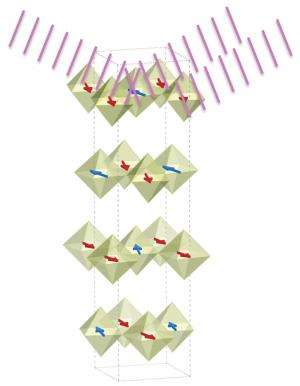X-ray resonance scattering can reveal the magnetic properties of transition metal oxides made out of heavy elements

Transition metal oxides are known for their interesting properties, including high-temperature superconductivity and resistance that can be tuned with a magnetic field. Researchers have mainly focused on oxides made from '3d' transition metals—the elements from scandium to zinc—but they are starting to uncover new material properties in oxides containing the much heavier '5d' transition metal elements found between hafnium and mercury.
Unfortunately, scientists have not been able to rely on their usual tool, neutron scattering, to study magnetic structure in these materials because the samples are often too small and 5d elements strongly absorb neutrons. Now, Shigeki Fujiyama at the RIKEN Advanced Science Institute and his colleagues have shown they can use x-rays to study magnetism in the 5d transition metal oxide Sr2IrO4 over a wide temperature range. "The sample size needed is three orders of magnitude smaller than what is needed for conventional neutron scattering experiments," explains Fujiyama, who says the technique will be important for studying other 5d transition metal oxides.
Atoms in a solid are magnetic if their valence electrons have a net (non-zero) angular momentum. The valence electrons' total angular momentum is a combination of their orbital motion about the nucleus and their 'spin'. In heavy elements, like iridium (Ir), a relativistic effect called the spin-orbit interaction causes the electrons' orbital momentum to drag their spin momentum with it. In materials where the spin-orbit effect is large, the electronic motion can be controlled to affect the magnetic properties (and vice versa).
In Sr2IrO4, a large spin-orbit interaction makes the material a 'Mott insulator', similar to La2CuO4, a 3d metal oxide that can be chemically modified to become a superconductor. In both materials, the magnetic ions (iridium and copper) also form the same magnetic structure—an antiferromagnet—at low temperature. It has not been clear if both magnetic structures can be described by the same models.
Fujiyama and his team therefore used resonance x-ray scattering, where the x-ray wavelength matches an absorption edge of the iridium ion so it is sensitive to the ion's magnetic state, to study the onset of magnetic order in Sr2IrO4. Their measurements, performed at the RIKEN SPring-8 synchrotron, show that magnetic order in Sr2IrO4 develops in two-dimensional planes first and only becomes three-dimensional near the anti-ferromagnetic transition, similar to La2CuO4. Similar oxides containing iridium may exhibit superconductivity or a 'quantum spin liquid' and Fujiyama's group is examining these possibilities.
More information: Fujiyama, S., Ohsumi, H. Komesu, T., Matsuno, J., Kim, B.J., Takata, M., Arima, T. & Takagi, H. Two-dimensional Heisenberg behavior of Jeff = ½ isospins in the paramagnetic state of the spin-orbital Mott insulator Sr2IrO4. Â鶹ÒùÔºical Review Letters 108, 24721 (2012).
Journal information: Â鶹ÒùÔºical Review Letters
Provided by RIKEN




















